-
Article
tells you the tradition of making Kolams in Tamil Nadu, the deeper significance
behind making it and benefits.
Tamasomā jyotir gamaya. Source is Brihadaranyaka Upanishad (1.3.28)
This
shloka literally means “from darkness lead me to light”.
Even
as the first rays of the Sun start colouring the sky at the break of dawn, the
streaks of the ‘kolam’ or ‘rangoli’ drawn outside innumerable homes in many
parts of India, herald the arrival of light dispelling darkness. While it is a
simple act of making a design usually with rice flour or chalk powder, outside
one’s doorstep, drawing of ‘kolam’ or ‘rangoli’ has a very deep social,
cultural and philosophical significance in the Indian way of life.
According to one of the stories found in the ‘Puranas’, it is believed that Goddess Lakshmi resides in homes that are clean, have clean entrances purified with cow-dung and decorated with beautiful ‘rangolis’.
‘Rangoli’ is derived from Sanskrit and is known by different names across the country – ‘kolam’ in Tamil Nadu and Kerala, ‘muggu’ in Andhra Pradesh and Telangana, ‘aripana’ in Bihar, ‘chowk pujan’ in Uttar Pradesh, ‘chaookpurana’ in Chattisgarh, ‘maandna’ in Rajasthan, ‘alpona’ in West Bengal and ‘muruja’, ‘jhoti’ or ‘chita’ in Odisha, to name a few. 'Sanskar bharati' in Maharashtra and 'sathiya' in Gujarat are among the different types of 'rangolis' drawn during auspicious occasions.
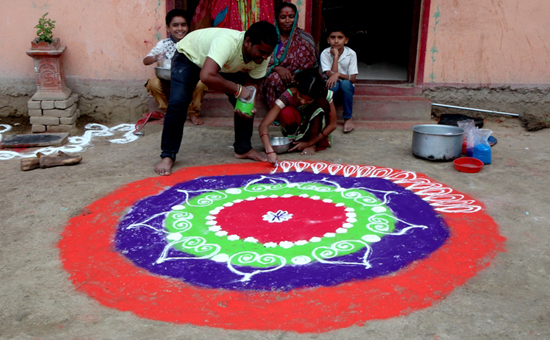 Raangoli at village Lonar, Maharashtra. Made during Ganapati. Pic by S Nayyar.
Raangoli at village Lonar, Maharashtra. Made during Ganapati. Pic by S Nayyar.
These patterns are drawn using materials such as rice flour in powder or paste forms, powder colours, white rock powder, chalk powder and flower petals at the entrances of homes and within, where daily ‘puja’ or worship is done. They are also drawn in front of the ‘tulsi’ plant. The practice of drawing ‘kolams’ on or in front of cooking stoves in the kitchen,
before starting the process of cooking, continues to this day in many
households.
Different
materials are used for making these patterns to mark different occasions. For instance,
during the festival of Onam in Kerala, it is traditional to make ‘kolams’ with
flower petals and these are called ‘pookalams’.
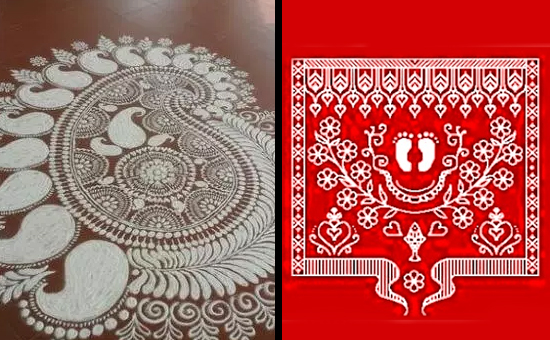 Left Alpona West Bengal. Right Maandna Rajasthan.
Left Alpona West Bengal. Right Maandna Rajasthan.
In
Tamil Nadu, ‘kolams’ are an integral part of daily life and are drawn not only
outside homes and temples, but also outside shops, commercial and corporate
establishments. Patterns are created by either joining dots (called ‘pullis’ in Tamil) to form various
designs or drawn freehand. Some very special and intricate ‘kolam’ designs are
passed on from one generation to another.
During festivals, weddings and other family functions ladies of the family and the neighbourhood come together to make elaborate ‘kolam’ designs. Children usually pick up the tradition by observing and helping their elders.
Why is ‘kolam’ such an important daily ritual?
It
is believed that drawing ‘kolam’ outside the
doorstep ushers in goodness and prosperity while also making the place
look beautiful and welcoming. Before making the ‘kolam’, the lady of the house
cleans the place in front of the house with water often mixed with some
cow-dung. This helps purify the environment around the house.
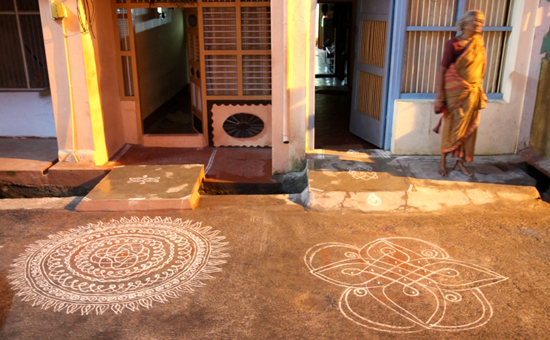 Early morning Kolam at Tenkasi Tamil Nadu. Pic by S Nayyar.
Early morning Kolam at Tenkasi Tamil Nadu. Pic by S Nayyar.
Drawing
these beautiful patterns every day symbolises the celebration of life, giving a positive start to the day. ‘Kolams’ are
believed to help channelize positive energies into one’s homes and workplaces,
while destroying negative energies at the same time. It has a cleansing and
calming effect on the mind and body of the woman, who is then ready to face the
rigours of the day ahead.
The
‘kolam’ is usually drawn using rice powder or paste
enabling ants, little insects and birds to feed on it. This tradition is
invariably an extension of the Indian ethos of oneness with nature fostering
the well-being of all living entities – the very epitome of the principle of
“Vasudhaiva kutumbakam” (the whole world is one single family). Importantly,
this is very well-entrenched in a simple ritual performed daily, making it a
way of life.
Apart
from inhaling the crisp and fresh morning air while stepping out to draw
‘kolams’, this activity has other health benefits as well. As women are
constantly bending down and straightening up as they make these patterns, it
helps strengthen their backs and avoid back pains. Interestingly in Tamil Nadu,
there is a type of ‘kolam’ design called ‘sikku
kolam’, wherein ‘sikku’ means knots. These designs
are particularly useful in sharpening creativity and problem-solving skills as they involve making complicated patterns that appear
symmetrical, when viewed from any direction.
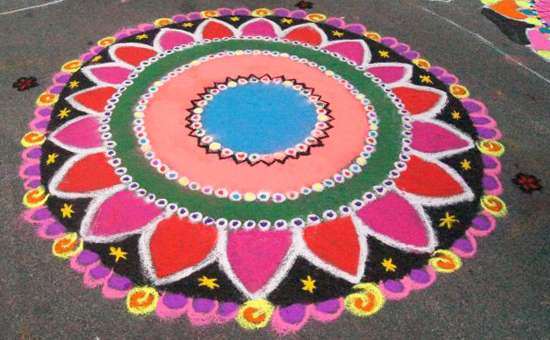 Kolam. Pic by Author.
Kolam. Pic by Author.
Vital element in every celebration
Special
designs are drawn to celebrate festivals and other important days and events. A
distinct pattern of ‘kolam’ called ‘hridaya
kamalam’ is believed to represent Goddess Lakshmi and is not drawn at the
entrances or outside homes. It is drawn only at the place of worship inside
homes or in front of the ‘tulsi’ plant.
During Krishna Janmashtami, tiny footprints symbolising the arrival of Lord Krishna are drawn from the entrances and thresholds leading up to the place where puja is done inside the homes. Similarly, footprints are also drawn to welcome Goddess Lakshmi for ‘Lakshmi Puja’, which is celebrated during Deepavali.
Large,
elaborate patterns are made for weddings and other key functions. Often,
professional ‘kolam’ artistes are entrusted with creating these designs for
such important events.
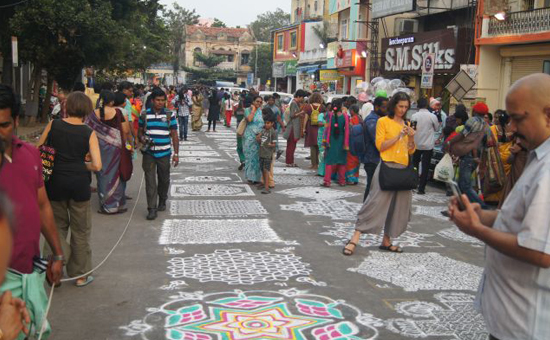 Kolam at Mylapore Festival January 2019. Pic by Author.
Kolam at Mylapore Festival January 2019. Pic by Author.
The
month of ‘Margazhi’ (mid-December to mid-January) is considered particularly
auspicious in Tamil Nadu and ‘kolam’ making is an integral aspect of the
celebrations during this month. As part of the Mylapore Festival held annually
in Chennai, one of the approach roads to the famous Kapaleeswarar Temple at
Mylapore, transforms into a grand canvas for ‘kolam’ artistes, who display
their expertise in the art and compete with each other. What started as a
simple neighbourhood ‘kolam’ contest around the mid-1990s, is now a major
cultural event attracting huge crowds, including several visitors from other
countries. People from different walks of life participate in this competition
to create exquisite ‘kolam’ designs on the street, over a 2-day period.
Signifying positive energies
Essentially
the harbingers of positive energies, ‘kolams’ symbolise the auspicious aspects
of life. In the event of a death in the family, the ‘kolam’ is not drawn during
the period of mourning. Even during annual ‘shraadham’ rituals for ancestors,
the ‘kolam’ is drawn only when these rituals are completed.
In case of special ‘pujas’ and rituals, including those that involve ‘tantra’, specific patterns of ‘kolams’ are made and following the exact measurements and dimensions are extremely important forming the basis for conducting the ritual. ‘Bhagavathy Sevai’, for
instance, based on tantric rituals and primarily conducted in Kerala and Tamil
Nadu, involves drawing of a special ‘kolam’ called ‘padmam’, on which Goddess
Durga is invoked. Two smaller patterns are drawn on either side of the ‘padmam’
– one for Lord Ganesha and the other for the ‘kula devata’ or family deity.
Rice powder, turmeric powder and kumkum powder (‘rakta choornam’) are used for
creating these patterns.
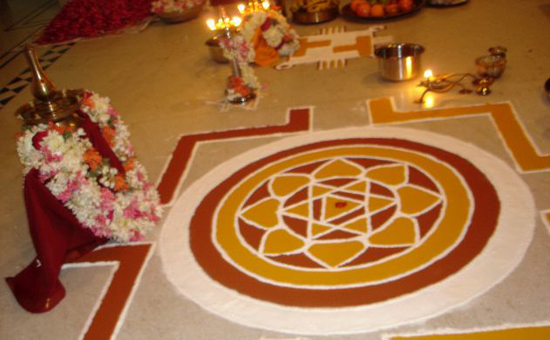 Kolam. Pic by Author.
Kolam. Pic by Author.
Even
as they contribute to aesthetics around the house in general, ‘kolams’ or
‘rangolis’ have an enormous spiritual import. These patterns celebrate new
beginnings, bring about a sense of symmetry and harmony in our day-to-day lives
and spread positive energies around our homes. In many ways, the unassuming
‘kolam’ or ‘rangoli’ is truly a manifestation of the divine in everyday places.
To hear a Podcast by Nandini Srinivasan titled - Kolam- Reconnecting the Dots of this Sacred Art
To read all
articles by Author